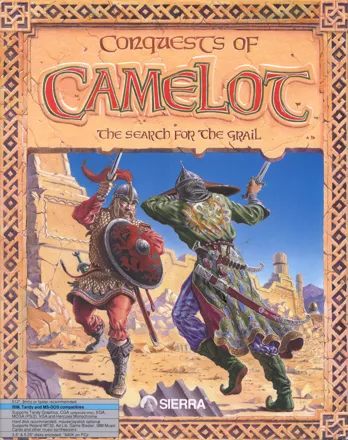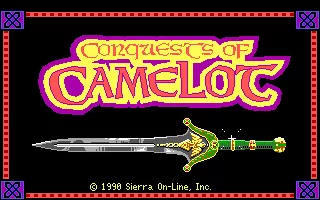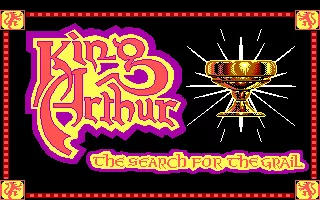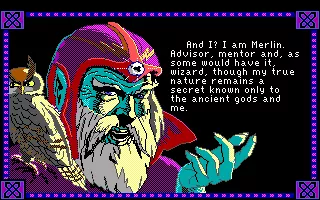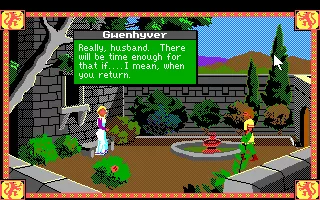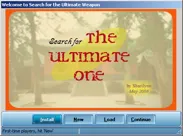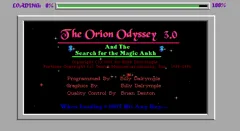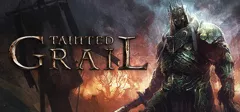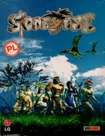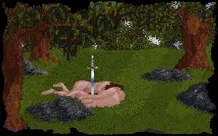Conquests of Camelot: The Search for the Grail
Description official description
It is the ninth century, and Camelot, the legendary castle ruled by King Arthur, has fallen under a curse. Famine and drought plague the kingdom because of the love triangle between the king, his wife Gwenhyver, and the knight Launcelot. It appears that only the mysterious Holy Grail can restore Camelot, and three knights - Launcelot, Gawaine, and Galahad - embark on a journey to find it, and soon disappear without a trace. King Arthur leaves his castle in search of the missing knights, hoping to locate the Grail as well. His quest takes him to real and mythical locations in England, and later to Jerusalem and other areas of the Holy Land.
Conquests of Camelot is an adventure game that requires the player to input text commands, mostly by combining verbs and objects (such as "look man", "take purse", etc). A few commands (such as "ask about") have keyboard shortcuts. Unlike most other adventures, the game does not focus extensively on inventory-based puzzles. Rather, it presents a diverse array of tasks depending on concrete situations. These involve exploration, solving riddles, gathering information, participating in arcade sequences such as jousting, and others. Rudimentary money management is present as well.
Many problems have different solutions, and it is possible to reach the final part of the game even without having completed some of the essential quests (e.g. failing to save the knights). However, Arthur is being judged by the game in three different categories: skill (referring to the action sequences), wisdom (evaluating the amount of cultural information gathered), and soul (determining the moral value of Arthur's action). Failure to achieve a high score in the last category leads to a bad ending.
The game is set in a concrete historical period, but adds an alternate reality to it, assuming that pagan deities really existed, but were overshadowed by Christian worship. However, there are only a few references to real religious practices of the time or any historical characters.
Groups +
Screenshots
Videos
Add Trailer or Gameplay Video +1 point
See any errors or missing info for this game?
You can submit a correction, contribute trivia, add to a game group, add a related site or alternate title.
Credits (DOS version)
35 People (34 developers, 1 thanks) · View all
| Executive Producer | |
| Game Designer | |
| Art Designer | |
| Producer | |
| Lead Programmer | |
| Composer | |
| Documentation | |
| Documentation Art | |
| Animators | |
| Background Artists | |
| Programmers | |
| Development System | |
| [ full credits ] | |
Reviews
Critics
Average score: 75% (based on 15 ratings)
Players
Average score: 3.7 out of 5 (based on 66 ratings with 7 reviews)
A gem from an unrepeatable era
The Good
"Can't you see, all around you, the Dragon's Breath?"...
The Bad
That last Skill Point that I still can't find after all these years. It's probably a bug, or you have to defeat the Saracen without getting hit, which I gave up trying ages ago! :-D
The Bottom Line
Out of Sierra’s golden age comes this somewhat overlooked, but memorable to those who have played it, adventure. The game takes us in the court of Camelot, where the secret lust of Queen Gwenhyver and Sir Launcelot has placed a curse upon the land. All will turn to ashes and dust unless the Holy Grail is retrieved. The kingdom’s greatest knights, Sir Gawaine, Sir Launcelot and Sir Galahad left to fulfil the task. Alas, they never returned. We, as King Arthur, now have the duty to take over the quest of finding the Grail, and also rescue the three knights. Arthur’s mentor, Merlin the wizard, will assist us from afar through a spirit link. During our search we will travel to enchanted places of mystery and dark secrets, face grave dangers and interact with extraordinary personalities.
“Conquests of Camelot: The search for the Grail” is one of the last games by Sierra to utilize the parser interface. We have to type short commands in order to do things. Conveniently, there are some shortcuts that save time (e.g. ctrl+a is ‘ask about’). The graphics were great for the time and they are still tolerable today. This is because they are well drawn, sharply defined and colorful. The game also features an inspired musical score. Melodious themes, for several occasions and places, play a supporting and sometimes dominating role, adding a lot to the atmosphere.
This adventure uses an interesting triadic score system. Skill points reward correct actions and successful battles, wisdom points are offered for knowledge use and enrichment. Finally soul points benefit ethical integrity and generosity. To make progress in all of these sectors we have to thoroughly inspect the areas we visit, inquire answers from Merlin and the characters we meet, and make the right decisions. The playing length is not very large, but it is definitely satisfying. Also, striving for missed points amplifies replay value. The manual is necessary for playing without problems, as it contains answers to basically copy protection questions that will appear during the game in the form of trials.
The weakest aspect of the title is the quality of the puzzles. Unfortunately, they lack the necessary complexity and challenge and can be characterized as shallow. When they are solved, they rarely cause that, well known to adventurers, special feeling of accomplishment. This is one the few areas where more effort and thought should have been applied. The game does its best to make up for this through some brilliant arcade sequences. In these we get to use our spear, lance and sword to vanquish our foes. The highlight is the final duel with the awesome Saracen. There are three levels of arcade difficulty that yield a different amount of skill points accordingly.
The game deals with the Arthurian tale in a deep and serious fashion. Designer Christy Marx researched myth, history and religion issues during the making of the game. The combination of various legends and traditions, along with the persistence to detail make an authentic and involving environment for the player. “Conquests of Camelot: The search for the Grail” deserves a place in our collection. Everyone with the desire for a nostalgic glance at the past of adventure gaming should unreservedly try it.
DOS · by Iron Lord (40) · 2016
Enjoyable, especially if you are interested in Greek/Roman mythology
The Good
There are quite a few games that focus on the Holy Grail, and Sierra's Conquests of Camelot: The Search for the Holy Grail is one of them.
The game starts off telling the player of the decline of Camelot as a result of the love triangle between King Arthur, Guinevere, and Lancelot. The other inhabitants of Camelot, Gawain, Lancelot and Galahad, had a vision of the Holy Grail and searched for it, never to return. King Arthur goes on a quest to find the three men and return with the Grail.
Arthur is assisted by Merlin to give him help and advice. You can ask about anything related to Greek or Roman mythology, and he will give you a lot of information regarding the subject. Furthermore, asking about objects in a particular location causes him to tell you about things that are related to Roman or Green mythology.
The adventure takes place around real locations in England, such as Glastonbury Tor and Southampton, as well as a few in the Middle East. Each of the game's locations look good, even in 16-color EGA, and this was at the time when VGA cards were not commonplace yet. If you have ScummVM and happen to have this game, you can load it up and select the undithered option. That way, the graphics don't have that checkerboard feel to them.
There are alternate solutions to puzzles, with some of these solutions leading to consequences. For example, much earlier in the game the player can decide whether to defeat the Black Knight in a joust match. If the player refuses to do so, then the Black Knight kills one of the knights you are meant to find. So, Conquests of Camelot is good on a replayability scale. Speaking of the jousting match, it is difficult to defeat your opponent, but it can be done. The animation of the Black Knight falling off his horse look excellent.
Since the game has a medieval setting, the music blends in well with both the setting and what you are doing. It sounds more realistic coming from a Roland MT-32 than an AdLib. The sound effects are well designed. I like the sound effects coming from the aforementioned sound device, especially when Arthur rides around on his horse.
The Bad
I don't like are those death messages that allow you to Restore, Restart, or Quit. Whereas death messages in other Sierra games are often informative and humorous, this one just says the same thing. To make up for it, there is an image of worms crawling out of your skull which looks nice.
I also didn't like the amount of copy protection in the game, which requires you to get out your Liber Ex Doctrina that came with the game to solve all of the game's puzzles.
The Bottom Line
So, for anyone who enjoys researching Greek or Roman mythology, or the evolution of Arthur and the Holy Grail, I would recommend this game. If you just like playing adventure games, especially from Sierra, then also give this game a try. Conquests was popular enough to warrant a sequel – from the same developer who brought you this game.
DOS · by Katakis | カタキス (43085) · 2014
One of the best Sierra games ever, makes you forget it's EGA
The Good
A review I read before buying, said the game was the best production of Sierra for 1990. I realised why.
The game can stand next to each other Sierra games and be judged as superior, almost for all its aspects. It's a real, serious, epic production, encompassing many elements that will satisfy the player. There is much travelling to many places, battles, choices to be made (affecting the course of the play), and much lore.
The graphics are really exceptional compared to the main corpus of Sierra. The sprites are richly animated, and there is much interaction with them (eg. you can kiss Gwynevere before leaving). The introductory scenes are well drawn, and resemble those that will be used in the cutscenes, much later in the Sierra VGA games.
The game is really atmospherical. Not only due to the graphics (I noted some anachronisms), but mainly because of the descriptions and dialogues. The messages are not the 'narrator's speech', but Merlin who communicates with you telepathically. All descriptions are supposedly personal views and knowledge of Merlin. Some scenes contain many objects and if you examine them, you will get immersive folkloric knowledge.
Interactivity is also rich. Almost everything you will try (like the F... word to people) will give you Merlin's appropriate reply. The designers have tried to predict as much of your thoughts as possible, often surprising you.
The game design also presents some differences. Here it's not easy to overlook something needed much later. Some choices you can make (Eg. not saving Lancelot, or giving the hag money instead of the artifact she wants) will affect something much later, but they are things that you know they are wrong, made only deliberately. In cases you will overlook or lose an artifact, its use would be only to make your life easier. The point where you will need it, you can also pass by trial and error
The soundtrack is one of the first I loved in games. I remember myself recording medieval melodies in my tape recorder!! So atmospheric that will put you in the position you should be. Medieval Britain, or the oriental Jerusalem, themusic is what you want to hear to put you in Arthur's shoes.
Last but not least, the package of the game is also one of the best I have seen. The box is beautifully drawn. It contains an also beautiful map of Europe (I am not not to decide it's historical accuracy), and an also beautiful manual, book of lore with information both educative, and useful (copy protection is based on it).
The Bad
People seem to dislike only one thing in this game: The riddles. Indeed the creator is overconcerned about piracy. Not only she gives a moral lecture on it in the manual, but there are also 3 points in the game where you will need to consult your manual for folk lore. Personally, after I grew up, I could solve them without help, because of my personal knowledge but the problem exists.
There is also a point where you must solve 'guess what' riddles, not with knowledge of the manual. This is indeed a hard part, and sometimes even today I get stuck. However you can exit and re-enter the screen to try for an easier random set of riddles.
There was another thing I didn't like. The game is called Conquests of Camelot. Not only Camelot is seen only in the start, but the game has nothing to do with the conquests, the reign, the history, enemies or victories of Camelot. After a point the game changes feel and atmosphere, and you forget the Arthurian concept altogether and start learning lore and explore catacombs. The game for the most part is not more Arthurian than any other medieval game is. It could be called 'Medieval Indiana Jones' and still be credible.
Well, a tiny part that I didn't like are some historical inaccuracies. AFAIK the labarum was never a symbol of Mithras.
The Bottom Line
This game is an ideal travel to the middle-ages, a taste of the spirit and folklore of those times, when the old and new world coexisted. Just 'look at' everything you see.. Travel many places, battle with foes, read about legends of medieval england, and you will experience a rich, full and satisfying adventure.
DOS · by Boston Low (85) · 2005
Discussion
| Subject | By | Date |
|---|---|---|
| Conflicting info about Conquests of Camelot | Bullyt (524) | Feb 13, 2009 |
| areas with un-implemented puzzles? | Pseudo_Intellectual (67780) | May 22, 2007 |
Trivia
Glastonbury Tor
A portion of the game takes place in Glastonbury Tor. British legends indeed connect the Tor with Avalon, King Arthur and the Grail. Joseph of Arimathea allegedly traveled to Britain and left the Grail in Glastonbury where an Abbey was later built
In the game, there is a little tree, and if the player examines it, narration will tell them that this thorn tree was planted by Joseph of Arimathea. That tree known as 'Glastonbury Holy Thorn' actually existed in the Abbey, and died in 1991 according to Wikipedia
Also, the cover lid of the well seen in the very same screen, is curiously similar to the lid of the Chalice Well, an actual natural spring that exists in the area
Manual
In some portions, Merlin (the narrator) will refer to the Liber ex Doctrina, the copy protection manual of the game. If the player types 'Ask Merlin about Liber ex Doctrina', the cover of the manual will appear in a dialog window and Merlin suspiciously will warn the player that he must always have it in hand. The manual's name Liber ex Doctrina means 'Free/Book from doctrine' in Latin. Note that in Latin, liber means both free and book.
References
- The ship's name reads KRISTI in Greek letters, a reference to Christie Marx.
- Also, a sign in Jerusalem reads LEDGER in Greek, for her husband and the game's illustrator
- If you have a Roland MT-32 connected to your machine and selected as your MIDI device: Start the game, and watch the display on the Roland very carefully. You will see several messages, including: 'Conquest of Camelot' '(It's Only A Model)' And when you quit the game it reads: 'HAM&JAM&SPAMALOT' This is a reference to the movie Monty Python and the Holy Grail
Red herrings
There are a couple of red-herring places the player can find, without any significance to the game: * One is the snake corner in the desert, found only if the player strays from his or her path. The player can kill one snake with the sword, but won't be able to go further. Also, if players lose their way in the desert, they will see hallucinations about Lancelot and Guenevere * The player can also follow the tunnel of the pool of Siloam, however the screens will gradually darken and the player will die if he or she goes further. That tunnel is also the place where the player is 'transported' should he or she try to escape the riddles of Fatima. * Another such useless place is a dirty alley in Jerusalem, with a carcass of a dog and a pool of urine. The wall features Latin writing saying 'PRO BONUM TEMPUS APPELA CRISTI' translated as 'For a good time, call Christy', an obvious pun (and quite self-sarcastic) about the game creator herself
Runes
If the player examines the pedestal where the hag was standing on, in the stone circle, a dialog window will open with an icon of a runic inscription and its 'translation'. According to the narrator, the runes say about the five stone poets, encountered later in the game.
However if anyone tries to translate the runes with English letters (such guides can be found anywhere online), the 'actual' inscription doesn't say anything like that. The inscription actually contains the word 'Stormbringer' followed by the phrases 'death is all' and 'beware cursed is the wielder Thor'.
Other runes and words are too difficult to make out
Information also contributed by Itay Shahar
Analytics
Related Sites +
-
Christy Marx's page for Conquests of Camelot: The Search for the Grail
The game's designer, Christy Marx has her own page for the game. -
Conquests of Camelot - FAQs & Guides
Various fact files and walkthroughs on GameFaqs.com
Identifiers +
Contribute
Are you familiar with this game? Help document and preserve this entry in video game history! If your contribution is approved, you will earn points and be credited as a contributor.
Contributors to this Entry
Game added by andyhat.
Amiga added by POMAH. Windows added by Cavalary. Atari ST added by Terok Nor.
Additional contributors: Jeanne, Sciere, Bullyt, Boston Low, formercontrib, Patrick Bregger, Melony Fruitloop.
Game added May 4, 2000. Last modified November 22, 2024.


